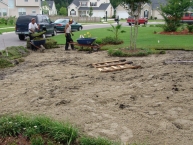When establishing a yard or renovating an existing one, you have two basic choices—seeding and sodding. Either, if done correctly, can result in the yard of your dreams, a lush lawn of green that beckons people to walk through it barefoot, kids to roll around in it, and neighbors to turn green with envy. Sod beats out seeding for many people as it’s almost an instant yard—you buy rolls, you put them down (or have someone else do it), and voila, there’s green where there wasn’t any green just hours before.
If you’re thinking about sod, for a new yard or patching up bare spots, be a savvy consumer and do some comparison shopping, as all sod is not alike. You’ll find this out fast if you call a few sod farms and ask for prices. Don’t be surprised if those prices vary a bit or a lot. There’s a reason for it, and even though the cheaper sod might seem like a good idea, it can end up taking a much larger chunk out of your wallet in the long run than the more expensive higher quality turf and varieties.
Here’s why: the cheaper sod might come from a “me too” farmer, someone who wants to get into the market and sells commodity grass at below market cost. It also may be coming from a field that has been sitting for a while after not being sold, making transplanting more difficult. The difference between these folks and the growers of good sod—people who do things the right way, who don’t cut corners, and who deliver a superior sod product—is that the other guys will, for lack of a better term, cheap out. They’ll just let their grass grow without the care and attention it needs. Many will let weeds go wild until the very end of production and hit them hard with chemicals. This kills the weeds, but it also weakens the grass just before it’s about to undergo the stress of being harvested and turned into sod. This practice can lead to grass that is more susceptible to drying out, failing to transplant, and dying which means buying all new grass and starting over again from scratch.
You might spend more money on the front end when you buy sod that’s been grown like it should be, but you’ll save time and money in the long run. If possible, visit local growers to see what their grass looks like. Ask them what they grow and how they grow it. If you’re in the southern U.S., look for some of our grasses—Empire Zoysia, Celebration Bermuda, and Palmetto St. Augustine. If you are up north, check out our Bella Bluegrass, HGT, or RPR. We develop them to perform well on the farm, survive transfer well, and to be easy to take care of. We handpick the sod farms that grow them, so you know they’re grown right.

